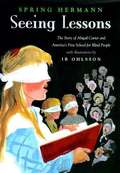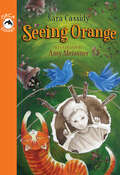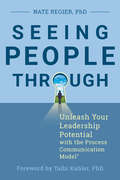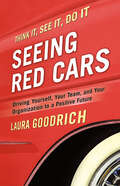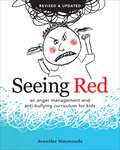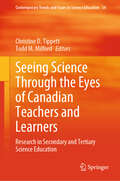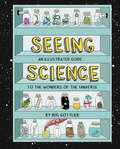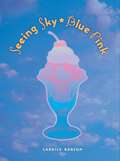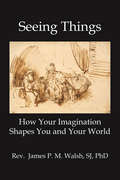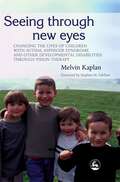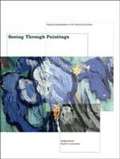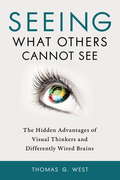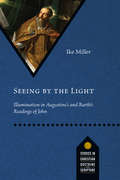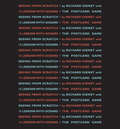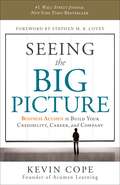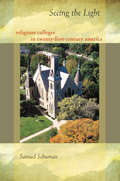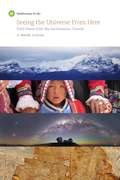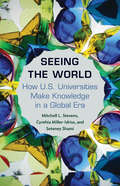- Table View
- List View
Seeing Jesus from the East: A Fresh Look at History’s Most Influential Figure
by Ravi Zacharias Abdu MurrayEncounter Jesus Like Never Before through Eastern EyesThroughout these pages, Ravi Zacharias and Abdu Murray invite readers to rediscover the cultural insights we often miss when we ignore the Eastern context of the Bible. They offer a refreshing picture of Jesus, one that appeals to Eastern readers and can penetrate the hearts and imaginations of postmodern Westerners.In Seeing Jesus from the East, Ravi Zacharias and Abdu Murray show us why a broader view of Jesus is needed - one that recognizes the uniquely Eastern ways of thinking and communicating found in the pages of the Bible. Zacharias and Murray capture a revitalized gospel message, presenting it through this Eastern lens and revealing its power afresh to Western hearts and minds.Incorporating story, vivid imagery, and the concepts of honor and shame, sacrifice, and rewards, Seeing Jesus from the East calls believers and skeptics, both Eastern and Western, to a fresh encounter with the living and boundless Jesus.
Seeing Lessons: The Story Of Abigail Carter And America's First School For Blind People
by Spring Hermann Ib OhlssonIn 1832, when Abigail Carter was only ten years old, two doctors from Boston invited her to be one of the first students in an experimental institution: a school for blind people. Abby and her younger sister Sophia, also blind, packed their bags and headed to the city. For the first time in their lives, the two girls were able to read a book for themselves and to write a letter to their father. <p><p> This small start-up school developed into the Perkins School for the Blind. From this school graduated Annie Sullivan, Helen Keller's influential teacher. <p> Readers who love Helen Keller's story won't want to miss this inspiring story of courage and perseverance.
Seeing Opera Anew: A Cultural and Biological Perspective
by Joseph ConeWhat people ultimately want from opera, audience research suggests, is to be absorbed in a story that engages their feelings, even moves them deeply, and that may lead them to insights about life and, perhaps, themselves. How and why can this combination of music and drama do that? What causes people to be moved by opera? How is it that people may become more informed about living and their own lives? Seeing Opera Anew addresses these fundamental questions. Most approaches to opera present information solely from the humanities, providing musical, literary, and historical interpretations, but this book offers a “stereo” perspective, adding insights from the sciences closely related to human life, including evolutionary biology, psychology, anthropology, and neuroscience. It can be hoped that academic specialists less familiar with the science will find points of interest in this book’s novel approach, and that open-minded students and inquisitive opera-goers will be stimulated by its “cultural and biological perspective.”
Seeing Orange (Orca Echoes)
by Sara CassidySeven-year-old Leland has trouble writing, but he loves drawing. Leland so dislikes his teacher that he conjures up Delilah, an imaginary seeing-eye dog to help him into class each day. When a neighborhood painter recognizes Leland's gifts as an artist, Leland grows more confident about the world as he uniquely sees it. And when his family's cat goes missing, it is Leland's keen observation skills that lead to finding him. Leland's newfound confidence helps him both confront and sympathize with his teacher, who only wishes Leland could be a bit more focused. The epub edition of this title is fully accessible.
Seeing Patients: A Surgeon’s Story of Race and Medical Bias, With a New Preface
by Augustus A. White III, MDGus White grew up on the wrong side of the color line in Jim Crow Tennessee, then became the first black medical student at Stanford and a top surgeon at Harvard. Throughout his career he has witnessed unconscious bias against nonwhite patients. Seeing Patients shares these sobering stories and outlines concrete solutions to medical inequity.
Seeing People Through: Unleash Your Leadership Potential with the Process Communication Model®
by Nate Regier, PhDNASA, Pixar Animation Studios, and BMW all use the Process Communication Model as a way of training leaders to connect effortlessly with anyone. This book simplifies the complex model to make it easy for anyone to use.Today, more than ever, leaders need a new style of leadership. They are realizing that true transformation happens through meaningful relationships, and discovering that the key to sustainable connections that create possibility and potential is through communication.In Seeing People Through, we take a deep dive into The Process Communication Model (PCM), a behavioral communication model that teaches people how to assess, connect, motivate, and resolve conflict by understanding the personality types that make up a person's whole self, which is the key to leveraging personality diversity.PCM is more than a lens for understanding how people see things differently; it's a deep journey into self-awareness and self-transformation. In this book, new emerging leaders, senior leaders, and seasoned consultants alike will develop a fresh and relevant framework on leadership that is consistent with emerging trends, and they will learn how individual and collective concerns can be reconciled in leadership.NASA, Pixar Animation Studios, and BMW are just some of the companies who have all used PCM as a way to build better relationships through authenticity, trust, agility, and positive influence-and now you can, too!
Seeing Red
by Jennifer SimmondsAnger is a natural human emotion, but if it isn't managed properly its effects can be devastating. Seeing Red is a curriculum designed to help elementary and middle-school aged students better understand their anger so they can make healthy and successful choices and build strong relationships. This completely revised and updated edition includes a comprehensive anti-bullying component, complete with cutting-edge material specific to cyber-bullying and social media.Designed especially for use with small groups, Seeing Red enables participants to learn from and empower one another. Its unique group process helps children and teens build important developmental objectives such as leadership skills (taking initiative, presenting in front of the group), social skills (taking turns, active listening), and building self-esteem (problem solving, interacting with peers). Key concepts and activities include: Spotting anger triggers and taking responsibility for mistakes Finding healthy ways to deal with provocation and avoiding losing control Identifying feelings, learning steps to control anger, and exploring consequencesFacilitators will learn how to empower participants through role playing; helping them to identify associated feelings and recognize negative behaviors. Each session includes objectives, a list of supplies, background notes and preparation tasks for the leader, a warm-up activity, an explanation of the various learning activities, and a closing activity. See for yourself why Seeing Red remains one of the most highly-regarded resources among professionals in the field of children's anger management.Jennifer Simmonds is lead program coordinator at Youth Grief Services and author of Children in Change.
Seeing Red Cars: Driving Yourself, Your Team, and Your Organization to a Positive Future
by Laura GoodrichSurely you’ve experienced something like this: you buy a red car, and suddenly red cars appear everywhere. Why? Because you’re focusing on red cars—and you get more of whatever you focus on. But much of the time, consciously and unconsciously, we dwell on what we don’t want, and that’s what we get. Drawing on the latest scientific research, Laura Goodrich shows you how to stop fixating on negatives and rewire your brain to focus on positive outcomes. Unique and practical exercises—including a free online toolkit—and dozens of enlightening real-life stories help you identify what you truly want so that it drives everything you do. And Goodrich shows how Seeing Red Cars can build organizational cultures in which employees are playing to their passions and strengths, focusing on what they want, and achieving breakthrough results.
Seeing Red: An Anger Management and Anti-Bullying Curriculum for Kids
by Jennifer SimmondsA unique, proven approach to anger management for elementary and middle-school aged children. Anger is a natural human emotion, but if it isn't managed properly its effects can be devastating. Seeing Red is a curriculum designed to help elementary and middle-school aged students better understand their anger so they can make healthy and successful choices and build strong relationships. This completely revised and updated edition includes a comprehensive anti-bullying component, complete with cutting-edge material specific to cyber-bullying and social media.Designed especially for use with small groups, Seeing Red enables participants to learn from and empower one another. Its unique group process helps children and teens build important developmental objectives such as leadership skills (taking initiative, presenting in front of the group), social skills (taking turns, active listening), and building self-esteem (problem solving, interacting with peers). Key concepts and activities include:Spotting anger triggers and taking responsibility for mistakesFinding healthy ways to deal with provocation and avoiding losing controlIdentifying feelings, learning steps to control anger and exploring consequences.Facilitators will learn how to empower participants through role playing, helping them to identify associated feelings and recognize negative behaviors. Each session includes objectives, a list of supplies, background notes and preparation tasks for the leader, a warm-up activity, an explanation of the various learning activities, and a closing activity. See for yourself why Seeing Red remains one of the most highly-regarded resources among professionals in the field of children's anger management.
Seeing Science Through the Eyes of Canadian Teachers and Learners: Research in Secondary and Tertiary Science Education (Contemporary Trends and Issues in Science Education #54)
by Christine D. Tippett Todd M. MilfordThis book showcases current science education research in Canada, from Grade 8 to university. It provides a rich portrait of science teaching and learning at the secondary and tertiary levels across content areas and research methodologies. Research contexts include chemistry, oceanography, physics, and STEM; research approaches include action research, case study, mixed methods, and document analysis. Chapters build upon themes that emerged from our previous Springer book Science Education in Canada (2019) including environmental education (e.g., ocean literacy, place-conscious pedagogy), Indigenous perspectives (e.g., water stewardship), and assessment (e.g., formative assessment practices), and represent a cross section of the current mosaic of science education research in Canada in high school settings (and beyond). This book, when taken in conjunction with its companion volume Exploring Elementary Science Teaching and Learning in Canada (2023), enables readers to develop an in-depth understanding of current science education research across the country. Although this book reflects a Canadian perspective, its themes are of interest to both domestic and international audiences.
Seeing Science: An Illustrated Guide to the Wonders of the Universe
by Iris GottliebFrom an illustrator for San Francisco’s Exploratorium, a visual journey that shows how beautiful science really is.With original illustrations that deftly explain the strange-but-true world of science, Seeing Science offers a curated ride through the great mysteries of the universe. Artist and lay scientist Iris Gottlieb explains among other things: neap tides, naked mole rats, whale falls, the human heart, the Uncertainty Principle, the ten dimensions of string theory, and how glaciers are like Snickers bars. With quirky visual metaphors and concise factual explanations, she offers just the right amount of information to stoke the curious mind with a desire to know more about the life forces that animate both the smallest cell and the biggest black hole. Seeing Science illustrates, explicates, and celebrates the marvels of science as only art can.
Seeing Sky-Blue Pink (Exceptional Reading And Language Arts Titles For Intermediate Grades Ser.)
by Candice RansomPlenty of things make eight-year-old Maddie nervous: her too-small feet, climbing high places, not always knowing what to say, and especially her new home in the Virginia countryside with Sam, her mom's new husband. To her surprise, Sam turns out to understand all those things and more—like how to learn the weather from a cat, what kind of treasure you can find at the dump, and where to find a color called sky-blue pink. Through her growing bond with Sam, Maddie finds the courage to face many of her fears and the wisdom to see things she never believed could be real.
Seeing Things: How Your Imagination Shapes You and Your World
by Reverend James P.M. WalshThe late Jesuit theologian shares how the imagination “animates our aspirations, our service, and a deeper connection to God and to one another” (John J. DeGioia, President of Georgetown University).“This book is a pedagogical memoir enabling the reader to enter the late Jesuit Professor James Walsh’s Georgetown University classroom in various moments. Rev. Walsh considered imagination central to lived religion in the broadest sense, namely the vision of the prophet, the exegesis of the theologian, the teaching of the professor, the preaching of the pastor, and the experiences of the student, the seeker and the believer. And [Seeing Things] stands as an eloquent and accessible mini-course in the place of imagination in moral theology, as well as the spiritual testament of a caring and loving teacher, healer, and friend.” —David Goldfrank, Professor of History, Georgetown University “This study is a fascinating presentation of how we imagine ourselves and the context of the world around us. Father Walsh’s long-standing commitment to helping his students and colleagues understand both elevates the text to a unique level of contemplation.” —Ronald Jonson, Professor Emeritus of History, Georgetown University
Seeing Through New Eyes: Changing the Lives of Children with Autism, Asperger Syndrome and other Developmental Disabilities Through Vision Therapy
by Stephen M. Edelson Melvin KaplanSeeing Through New Eyes offers an accessible introduction to the treatment of visual dysfunction, a significant but neglected problem associated with autism spectrum disorders (ASDs) and other developmental disabilities. Dr. Kaplan identifies common ASD symptoms such as hand-flapping, poor eye contact and tantrums as typical responses to the confusion caused by vision disorder. He also explains the effects of difficulties that people with autism experience with "ambient vision", including a lack of spatial awareness and trouble with coordination. Other chapters give guidance on how to identify the visual deficits of nonverbal children, select prism lenses that will alter the visual field, and create individually tailored programs of therapy in order to retrain the system. This book is essential reading for parents of children with ASDs, and professionals in the fields of autism, optometry and ophthalmology, psychology and education.
Seeing Through Paintings: Physical Examination in Art Historical Studies
by Andrea Kirsh Rustin S. LevensonThis prize-winning book offers the only comprehensive discussion available on materials, techniques, and condition issues in Western easel paintings from medieval times to the present. "An essential handbook for the pro, and also a beautifully illustrated primer for the layperson. Kirsh and Levenson teach the most valuable lessons about painting of all: how meanings, material, and techniques are bound up together. "--John Walsh, former director, J. Paul Getty Museum "Every element of Kirsh and Levenson's book is smart, concise, and informative. . . . [It is] the essential book on its subject. "--Kenneth Baker,San Francisco Examiner & Chronicle "A long overdue book with direct relevance for modern students of the history of art. "--Libby Sheldon,Burlington Magazine
Seeing What Others Cannot See: The Hidden Advantages of Visual Thinkers and Differently Wired Brains
by Thomas G. WestFor over 25 years, Thomas G. West has been a leading advocate for the importance of visual thinking, visual technologies and the creative potential of individuals with dyslexia and other learning differences. In this new book, he investigates how different kinds of brains and different ways of thinking can help to make discoveries and solve problems in innovative and unexpected ways. West focuses on what he has learned over the years from a group of extraordinarily creative, intelligent, and interesting people -- those with dyslexia, Asperger's syndrome, and other different ways of thinking, learning, and working. He shows that such people can provide important insights missed by experts as they also can prevent institutional "group think." Based on first-person accounts, West tells stories that include a dyslexic paleontologist in Montana, a special effects tech who worked for Pink Floyd and Kiss and who is now an advocate for those with Asperger's syndrome, a group of dyslexic master code breakers in a British electronic intelligence organization, a Colorado livestock handling expert who has become a forceful advocate for those with autism and a family of dyslexics and visual thinkers in Britain that includes four winners of the Nobel Prize in Physics. He also discusses persistent controversies and the unfolding science. This is an inspiring book that not only documents the achievements of people with various learning differences, but reveals their great potential -- especially in a new digital age where traditional clerical and academic skills are less and less important while an ability to think in pictures and to understand patterns using high-level computer information visualizations is rapidly increasing in value in the global economic marketplace.From the Trade Paperback edition.
Seeing What Others Don't: The Remarkable Ways We Gain Insights
by Gary KleinInsights--like Darwin’s understanding of the way evolution actually works, and Watson and Crick’s breakthrough discoveries about the structure of DNA--can change the world. We also need insights into the everyday things that frustrate and confuse us so that we can more effectively solve problems and get things done. Yet we know very little about when, why, or how insights are formed--or what blocks them. In Seeing What Others Don’t, renowned cognitive psychologist Gary Klein unravels the mystery. Klein is a keen observer of people in their natural settings--scientists, businesspeople, firefighters, police officers, soldiers, family members, friends, himself--and uses a marvelous variety of stories to illuminate his research into what insights are and how they happen. What, for example, enabled Harry Markopolos to put the finger on Bernie Madoff? How did Dr. Michael Gottlieb make the connections between different patients that allowed him to publish the first announcement of the AIDS epidemic? What did Admiral Yamamoto see (and what did the Americans miss) in a 1940 British attack on the Italian fleet that enabled him to develop the strategy of attack at Pearl Harbor? How did a "smokejumper” see that setting another fire would save his life, while those who ignored his insight perished? How did Martin Chalfie come up with a million-dollar idea (and a Nobel Prize) for a natural flashlight that enabled researchers to look inside living organisms to watch biological processes in action? Klein also dissects impediments to insight, such as when organizations claim to value employee creativity and to encourage breakthroughs but in reality block disruptive ideas and prioritize avoidance of mistakes. Or when information technology systems are "dumb by design” and block potential discoveries. Both scientifically sophisticated and fun to read, Seeing What Others Don’t shows that insight is not just a "eureka!” moment but a whole new way of understanding.
Seeing and Writing (4th edition)
by Donald Mcquade Christine McquadeSeeing & Writing 4, with a new look, new features, and new essays and images, continues to lead the way as a visual, flexible, and above all, inspiring tool for the composition classroom.
Seeing by the Light: Illumination in Augustine's and Barth's Readings of John (Studies in Christian Doctrine and Scripture)
by Ike MillerHow can we understand God's revelation to us?
Seeing from Scratch: Fifteen Lessons with Godard
by Richard DienstTaking as his starting point fifteen characteristically penetrating epigrams by Jean-Luc Godard, Richard Dienst invites us to trace a new path through some of the fundamental questions of cinema. Godard has never stopped offering lessons about seeing and thinking, always insisting that we have to learn how to start over. By starting over "from scratch," Godard challenges us to rethink our ideas about embodied perception, material form and the politics of making images. Less a commentary on Godard's oeuvre than an outline of a Godardian pedagogy, Seeing from Scratch offers a theoretical exercise book for students, teachers and practitioners alike, pursuing unexpectedly far-reaching ways to think through images. Along the way we encounter, in this brief, accessible essay, ideal for classroom use, a wide range of thinkers whose ideas are put to use working through the intellectual and aesthetic questions and challenges Godard's epigrams suggest – not in the abstract, but as part of the book's practical approach to intellectual problem solving. In its conversational tone, return to fundaments and practical pedagogical approach, Seeing from Scratch is an essay for the media age in the mould of John Berger's Ways of Seeing from the 1970s: a new way of discussing the theory and practice of images and the film image. A companion piece, "The Postcard Game," presents a scene from an imaginary classroom, where a stack of postcards – like those found throughout Godard's work – provokes a spiralling series of questions about images, texts and the manifold pathways of the creative process.
Seeing from Scratch: Fifteen Lessons with Godard
by Richard DienstTaking as his starting point fifteen characteristically penetrating epigrams by Jean-Luc Godard, Richard Dienst invites us to trace a new path through some of the fundamental questions of cinema. Godard has never stopped offering lessons about seeing and thinking, always insisting that we have to learn how to start over. By starting over "from scratch," Godard challenges us to rethink our ideas about embodied perception, material form and the politics of making images. Less a commentary on Godard's oeuvre than an outline of a Godardian pedagogy, Seeing from Scratch offers a theoretical exercise book for students, teachers and practitioners alike, pursuing unexpectedly far-reaching ways to think through images. Along the way we encounter, in this brief, accessible essay, ideal for classroom use, a wide range of thinkers whose ideas are put to use working through the intellectual and aesthetic questions and challenges Godard's epigrams suggest – not in the abstract, but as part of the book's practical approach to intellectual problem solving. In its conversational tone, return to fundaments and practical pedagogical approach, Seeing from Scratch is an essay for the media age in the mould of John Berger's Ways of Seeing from the 1970s: a new way of discussing the theory and practice of images and the film image. A companion piece, "The Postcard Game," presents a scene from an imaginary classroom, where a stack of postcards – like those found throughout Godard's work – provokes a spiralling series of questions about images, texts and the manifold pathways of the creative process.
Seeing the Big Picture: Business Acumen to Build Your Credibility, Career, and Company
by Kevin CopeWhether you're on the manufacturing floor or sitting in the corner office, you can learn how to follow the drivers through to measurable results--conquering your fear of numbers. Using Kevin's simple explanations of the most important metrics presented in the income statement, the balance sheet, and the statement of cash flows.
Seeing the Light: Religious Colleges in Twenty-First-Century America
by Samuel SchumanSamuel Schuman examines the place of religious colleges and universities, particularly evangelical Protestant institutions, in contemporary American higher education. Many faith-based schools are flourishing. They have rigorous academic standards, impressive student recruitment, ambitious philanthropic goals, and well-maintained campuses and facilities. Yet much of the U.S. higher-education community ignores them or accords them little respect. Seeing the Light considers, instead, what can be learned from the viability of these institutions. The book begins with a history of post secondary U.S. education from the perspective of the religious traditions from which it arose. After focusing briefly on nonevangelical institutions, Schuman next looks at three Roman Catholic institutions—the College of New Rochelle, Villanova University, and Thomas Aquinas College. He then profiles evangelical colleges and universities in detail, discovering the factors contributing to their success. These institutions range from nationally recognized to little known, from rich to poor, with both highly selective and open admission requirements. Interviews with key administrators, faculty, and students reveal the challenges, the successes, and the goals of these institutions. Schuman concludes that these schools—Baylor University, Anderson University, New Saint Andrews College, Calvin College, North Park University, George Fox University, Westmont College, Oral Roberts University, Northwestern College, and Wheaton College—and others like them offer important and timely lessons for the broader higher-education community.
Seeing the Universe From Here: Field Notes from My Smithsonian Travels
by G. Wayne CloughAs the Smithsonian Institution's twelfth Secretary, Dr. G. Wayne Clough traveled extensively to connect with researchers and gain a better understanding of the scope of the Institution's work. While the Smithsonian is comprised of nineteen museums and galleries, a National Zoological Park, and nine research facilities, it also has a research presence in more than one hundred countries.During his six years as secretary, Dr. Clough kept a detailed journal of his experiences and discoveries while on his travels, ranging from anthropology in Antarctica to pre-Columbian history in Peru from astrophysics in the Andes and the mountains of Hawaii to coral reef ecosystems off the coast of Belize, and from climate change in Wyoming to preserving endangered species in Kenya and Panama. Seeing the Universe From Here offers a firsthand perspective of the Smithsonian's global relevance in these progressive fields.
Seeing the World: How US Universities Make Knowledge in a Global Era
by Mitchell L. Stevens Cynthia Miller-Idriss Seteney ShamiAn in-depth look at why American universities continue to favor U.S.-focused social science research despite efforts to make scholarship more cosmopolitanU.S. research universities have long endeavored to be cosmopolitan places, yet the disciplines of economics, political science, and sociology have remained stubbornly parochial. Despite decades of government and philanthropic investment in international scholarship, the most prestigious academic departments still favor research and expertise on the United States. Why? Seeing the World answers this question by examining university research centers that focus on the Middle East and related regional area studies.Drawing on candid interviews with scores of top scholars and university leaders to understand how international inquiry is perceived and valued inside the academy, Seeing the World explains how intense competition for tenure-line appointments encourages faculty to pursue “American” projects that are most likely to garner professional advancement. At the same time, constrained by tight budgets at home, university leaders eagerly court patrons and clients worldwide but have a hard time getting departmental faculty to join the program. Together these dynamics shape how scholarship about the rest of the world evolves.At once a work-and-occupations study of scholarly disciplines, an essay on the formal organization of knowledge, and an inquiry into the fate of area studies, Seeing the World is a must-read for anyone who cares about the future of knowledge in a global era.

